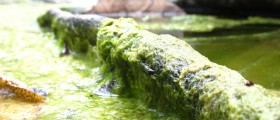
Overview of Fluorine
Fluorine is a pale yellow gas with a very high electron affinity, and is a very powerful oxidizing agent. Being a highly reactive element, fluorine is never found as a free element in nature. In addition, when fluorine comes into contact with other elements it forms a compound termed fluoride. Hydrogen fluoride, for instance, is a type of fluorine compound, which is very corrosive in water. There are also types of organic fluorides, which can be water repellants, have strong thermal and chemical stability, and can melt and boil at low points. Fluorine compounds also have commercial uses, as they are employed as refrigerator gases as well as for making Teflon in cookware. Although fluorine does have some health benefits it is not necessary for humans. Fluorine itself can be highly toxic, and so can many of its compounds, but it is regularly used by pharmaceutical companies for making new medications.
Physical and Chemical Characteristics of Fluorine
Fluorine atom has 9 protons and electrons. Fluorine’s outer electrons are spread out and have a high effective nuclear charge of +7. Fluorine holds its own electrons very tightly and attracts one additional electron, which allows it to have a stable neon arrangement. From the chemical standpoint, fluorine is the most electronegative element. As fluorine is so reactive, its encounters with other elements are usually explosive. Fluorine is so reactive that when it comes into contact with water it creates a bright flame. As far as the formation of compounds with metals is concerned, most of the metals are powdered.
Is Fluorine Healthy?
Fluorine is a substance that can be found in plants, animals, air, and water. Subsequently, individuals come into contact with fluorine often through breathing air, eating food, and drinking water. Relatively small amounts of fluorine are present in most foods whereas shellfish and tea contain larger quantities of the element. The main purpose of fluorine is to increase the density of the bones and prevent tooth decay if applied twice every day through toothpaste. On the other hand, excess amounts of fluorine lead to various health issues such as osteoporosis and kidney, bone, nerve, and muscle problems. Some types of fluorine compounds, which are put in water, toothpaste, and supplement vitamin tablets, have not been tested for safety before approval. Many clinicians agree that large amounts of fluorine can lead to birth defects, lower IQ, impaired immune system, and cancer. In addition, some experts agree that a proper dosage of fluoride is healthy, especially when it comes to calcium fluoride. Fluoride is a natural antiseptic, and as a result shields the body from infections. In order to get an adequate dosage of fluorine, it is recommended that individuals drink 1 to 2 cups of tea per day. Whole grains are also high in fluorine, making oatmeal, whole-wheat pasta and brown rice good sources of the substance. Various types of dairy products, such as sour cream, milk, cheese, and yogurt, are very rich is fluorine. Seafood in general is very healthy, and it is recommended that salmon, tuna, and seaweeds be regulars on the menu. Lastly, green vegetables are enriched with fluorine, and other minerals and vitamins as well. Other than green leafy veggie, potatoes, garlic, carrots, and peas are all known to contain required amounts of fluorine. Yet, there is another group of experts, which is relatively neutral when it comes to the effects of fluorine. For instance, numerous animal lab studies could not confirm a link between fluoride exposure and increased instances of cancer. Similarly, drinking water, which contains fluoride, has not affected the development of fetuses in most animal lab experiments. Furthermore, various research studies did not find a link between drinking water into which additional amounts of fluoride had been added and cancer in humans. Other than protecting teeth from cavities, there are no other attributable health effects of fluoride on humans.
What Environmental Effects does Fluorine Have?
Fluorine is emitted from factories and in small amounts usually leads to nose and eye infections. However, industry emitted fluorine is known to cause death as well. Also, fluorine that naturally exists in the air finds its way into water and soil where it cannot be eliminated. From the soil fluorine gathers up in the plants where it can trigger leave damage and debilitated growth. Plants that are more sensitive to fluorine are apricots and corn, whose crop yields can be substantially removed. In addition, when animals feed on the plants containing fluorine they ingest the substance that can cause bone and tooth degeneration, low birth weight, and abnormal claw development. Different animal species react to fluoride exposure differently. In birds it can affect chick growth, while in sheep, deer, and cattle, fluoride has been linked to low milk production, problems with teeth, bones, and joints, and with weight loss.

















Your thoughts on this
Loading...